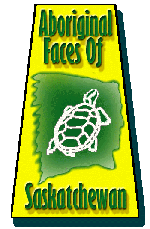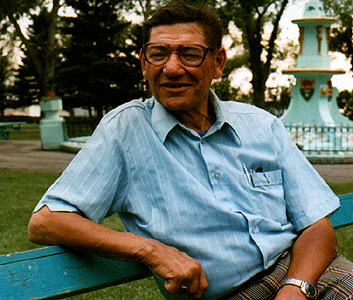|
|
||||||||
FSIN: A Look at Leaders By Christa Nicholat Reprinted
with permission from
David Knight was born on April 10, 1915 at Moose Lake Mountain and was raised on the John Smith Reserve(Muskoday First Nation), near Prince Albert. He served as president of the FSI from 1961 to 1964. In 1940 David married Lillian Umpherville and together they had nine children, including seven sons and two daughters. David farmed for three years before joining the Armed Forces of Canada with the onset of the Second World War. Mr. Knight began his political career after he was discharged from the army. He was elected to the council of the John Smith band in 1947 and served in this capacity until 1954 when he was elected as Chief of the band. He served as Chief from 1954 to 1956 and 1959 till 1963. Knight was elected first vice-president if the FSI in 1958 and president in 1961, a position he held until 1964. Following the end of his term, Knight began a career in the latter part of 1964 with the Department of Indian Affairs, where he worked for the next sixteen years, holding various positions within the department. The next president of the FSI, Wilfred Bellegarde served as president from 1964-1966, closely resembling David Knight in a number of respects. Bellegarde, born on July 23, 1921 on the Little Black Bear reserve and attended Lebret Residential School for eleven years. Upon finishing his schooling, Wilfred joined the army for about three and a half years. After he was discharged from the army in the mid-1930's, he joined the work force as a labourer. Bellegarde became involved in politics during the 1946 meetings in Saskatoon to discuss the feasibility of creating a single provincial Indian organization. Three years later in 1949, Bellegarde was elected Chief of Little Black Bear, a position he held for the next twenty-three years. Prior to being elected president of the FSI in 1964, Bellegarde held various positions on the FSI executive, including secretary, first and second vice-president. Bellegarde then joined the Department of Indian Affairs in 1965 as a community development worker. The similarities between David Knight and Wilfred Bellegarde are notable. Both men were in the army, both elected Chief of their bands, both were elected to positions on the FSI executive and presidency, and both went on to careers with the Department of Indian Affairs. Neither Knight nor Bellegarde did not seem to fit the aggressive, confrontational image of the war veteran leaders. It has been argued that all the war veterans of the FSI in the 1960's were more vocal and aggressive than previous leaders, regarding their political tactics and their relationship with the government. This is not the case, however, with Knight and Bellegarde. These men seem to lean more towards the "traditional leader" image like Tootoosis. This could be explained by the fact that both Knight and Bellegarde, like Tootoosis, were witness to the creation of the USI and the FSI, resulting in both of them practicing and reflecting the earlier style of leadership associated with Tootoosis. Interestingly, very little material can be found on president Knight and Bellegarde or their policies. One reason for this could be that no major policies were implemented during this period. Perhaps this is because Knight was only in office for three years and Bellegarde for only two, the shortest terms of any of the presidents or chiefs, excluding Albert Bellegarde, who passed away suddenly a year into his term. Conversely, maybe Knight and Bellegarde were only in office for three and two years, respectively, because of the lack of policies that were being implemented. Links: |
|||||||||









 This
month Eagle Feather News will feature presidents David
Knight and Wilfred Bellegarde, as we continue our
portrayal of the Federation of Saskatchewan Indian
Nations. David Knight and Wilfred Bellegarde, as well as
the next two presidents, Walter Deiter and David
Ahenakew, were similar in that they were all war
veterans. These veterans made up the core of the
leadership in the late 1960's. They felt that the issues
they fought for in other countries, such as ending
colonialism and promoting the self-determination of
peoples, must also apply to Indian people in Canada.
These men wanted to put an end to the dictorial rule of
Indian agents, or "Little Hitlers," as they
were called. These leaders spoke fluent English, knew how
the system worked, and were not afraid to confront the
government to achieve their ends. Even within this
seemingly homogeneous group, however, there were great
differences.
This
month Eagle Feather News will feature presidents David
Knight and Wilfred Bellegarde, as we continue our
portrayal of the Federation of Saskatchewan Indian
Nations. David Knight and Wilfred Bellegarde, as well as
the next two presidents, Walter Deiter and David
Ahenakew, were similar in that they were all war
veterans. These veterans made up the core of the
leadership in the late 1960's. They felt that the issues
they fought for in other countries, such as ending
colonialism and promoting the self-determination of
peoples, must also apply to Indian people in Canada.
These men wanted to put an end to the dictorial rule of
Indian agents, or "Little Hitlers," as they
were called. These leaders spoke fluent English, knew how
the system worked, and were not afraid to confront the
government to achieve their ends. Even within this
seemingly homogeneous group, however, there were great
differences.